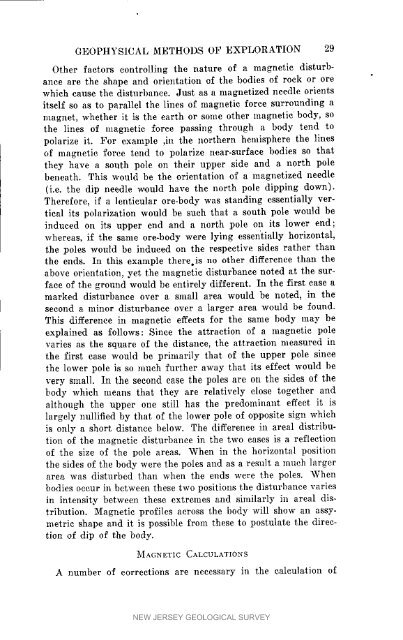Bulletin 54. Geophysical Methods of Exploration and their ...
Bulletin 54. Geophysical Methods of Exploration and their ...
Bulletin 54. Geophysical Methods of Exploration and their ...
Create successful ePaper yourself
Turn your PDF publications into a flip-book with our unique Google optimized e-Paper software.
GEOPHYSICAL METHOI_S OF EXPLORATION 29<br />
Other factors controlling the nature <strong>of</strong> a magnetic disturbance<br />
are the shape <strong>and</strong> orientation <strong>of</strong> the bodies <strong>of</strong> rock or ore<br />
which cause the disturbance. Just as a magnetized needle orients<br />
itself so as to parallel the lines <strong>of</strong> maguetic force surrounding a<br />
magnet, whether it is the earth or some other magnetic body, so<br />
the lines <strong>of</strong> magnetic _orce passing through a body tend to<br />
polarize it. For example ,in the northern hemisphere the lines<br />
<strong>of</strong> magnetic force teud to polarize near-surface bodies so that<br />
they have a smith pole on <strong>their</strong> upper side <strong>and</strong> a north pole<br />
beneath. This would be the orientation <strong>of</strong> a magnetized needle<br />
(i.e. the dip needle would have the north pole dipping down).<br />
Therefore, if a lenticular ore-body was st<strong>and</strong>ing essentially vertical<br />
its polarization would be such that a south pole would be<br />
induced on its upper end <strong>and</strong> a north pole on its lower end;<br />
whereas, if the same ore-body were lying essel_tially horizontal,<br />
the poles would be induced on the respective sides rather than<br />
the euds. In this example there is no other difference than the<br />
above orientation, yet the magnetic disturbance noted at the sur.<br />
face <strong>of</strong> the ground would be entirely different. In the first case a<br />
marked disturbance over a small area would be noted, in the<br />
second a minor disturbance over a larger area would be found.<br />
This difference in magnetic effects for the same body may be<br />
explained as follows: Since the attraction <strong>of</strong> a magnetic pole<br />
varies as the square <strong>of</strong> the distance, the attraction measured in<br />
the first case would be primarily that <strong>of</strong> the upper pole since<br />
the lower pole is so much further away that its effect would be<br />
very small. In the second ease the poles are o11 the sides <strong>of</strong> the<br />
body which means that they arc relatively close together <strong>and</strong><br />
although the upper one still has the predominant effect it is<br />
largely nullified by that <strong>of</strong> the lower pole <strong>of</strong> opposite sign which<br />
is only a short distance below. The difference iu areal distribution<br />
<strong>of</strong> the magnetic disturbance in the two cases is a reflection<br />
<strong>of</strong> the size <strong>of</strong> the pole areas. When in the horizontal position<br />
the sides <strong>of</strong> the body were the poles <strong>and</strong> as a result a much larger<br />
area was disturbed than when the ends were the poles. When<br />
bodies occur in between these two positions the disturbance varies<br />
in intensity between these extremes <strong>and</strong> sbuilarly in areal distribution.<br />
Magnetic pr<strong>of</strong>iles across the body will show an assymetric<br />
shape <strong>and</strong> it is possible from these to postulate the direction<br />
<strong>of</strong> dip <strong>of</strong> the body.<br />
MAGNETIC<br />
CALCULATIONS<br />
A number <strong>of</strong> corrections are necessary in the calculation <strong>of</strong><br />
NEW JERSEY GEOLOGICAL SURVEY

















